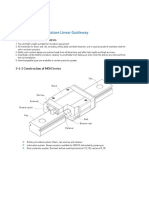Scheduling Techniques & Project Management
Scheduling Techniques & Project Management
Uploaded by
sushant_jhawerCopyright:
Available Formats
Scheduling Techniques & Project Management
Scheduling Techniques & Project Management
Uploaded by
sushant_jhawerOriginal Description:
Original Title
Copyright
Available Formats
Share this document
Did you find this document useful?
Is this content inappropriate?
Copyright:
Available Formats
Scheduling Techniques & Project Management
Scheduling Techniques & Project Management
Uploaded by
sushant_jhawerCopyright:
Available Formats
Scheduling Techniques & Project Management
Project management is the process by which a proposed project is developed
within a rigorous framework. The subset of project management that this lecture
will focus on is 'project scheduling', that is the process by which the various
activities that need to be undertaken during a projects lifetime should be
scheduled. There are a range of activity management tools that are commercially
available.
1. Project Scheduling
Project scheduling is concerned with the techniques that can be employed to
manage the activities that need to be undertaken during the development of a
project.
Scheduling is carried out in advance of the project commencing and involves:
identifying the tasks that need to be carried out;
estimating how long they will take;
allocating resources (mainly personnel);
scheduling when the tasks will occur.
nce the project is underway control needs to be e!erted to ensure that the plan
continues to represent the best prediction of what will occur in the future:
based on what occurs during the development;
often necessitates revision of the plan.
"ffective project planning will help to ensure that the systems are delivered:
within cost;
within the time constraint;
to a specific standard of quality.
Two project scheduling techniques will be presented, the #ilestone $hart %or
&antt $hart' and the (ctivity )etwork.
2. Milestone Charts
#ilestones mark significant events in the life of a project, usually critical activities
which must be achieved on time to avoid delay in the project.
#ilestones should be truely significant and be reasonable in terms of deadlines
%avoid using intermediate stages'.
"!amples include:
installation of equipment;
completion of phases;
file conversion;
1
cutover to the new system.
2.1 Gantt Charts
( &antt chart is a hori*ontal bar or line chart which will commonly include the
following features:
activities identified on the left hand side;
time scale is drawn on the top (or bottom) of the chart;
a horizontal open oblong or a line is drawn against each activity indicating
estimated duration;
dependencies between activities are shown;
at a review point the oblongs are shaded to represent the actual time spent (an
alternative is to represent actual and estimated by 2 separate lines);
a vertical cursor (such as a transparent ruler) placed at the review point makes it
possible to establish activities which are behind or ahead of schedule.
Project management tools incorporating &antt $harts include P+,)$" -$$T(,
.//01, #acProject and #icrosoft Project.
"!ample of a &antt $hart:
Figure 1: Example of a Gantt Chart
2hich tasks is ahead of schedule 3 2hich task is behind schedule 3
2
(lternative &antt $hart incorporating features commonly present in automated
tools:
Figure 2: Example of a Gantt Chart showing Project Management ool Features
&antt charts produced in this form are:
graphical;
easy to read;
easy to update.
There are no widely accepted standards for &antt charts. (utomated tools are
available which produce &antt charts directly from activity networks or from a full
definition of the tasks.
(utomated tools have features which assist the planning function including:
display of original and latest time for task;
display of person(s) allocated to tasks;
integration with other planning techniques (i.e. networks and milestones).
)ow try to create a &antt chart from the information presented in the &antt $hart
tutorial.
3. Activit !et"or#s
The foundation of the approach came from the Special Projects ffice of the 4S
)avy in ./56. ,t developed a technique for evaluating the performance of large
development projects, which became known as P"+T 7 Project "valuation and
+eview Technique. ther variations of the same approach are known as the
critical path method %$P#' or critical path analysis %$P('.
The heart of any P"+T chart is a network of tasks needed to complete a project,
showing the order in which the tasks need to be completed and the
dependencies between them. This is represented graphically:
Figure !: Example of an "cti#it$ %etwor&
The diagram consists of a number of circles, representing events within the
development lifecycle, such as the start or completion of a task, and lines, which
represent the tasks themselves. "ach task is additionally labelled by its time
duration. Thus the task between events 8 9 5 is planned to take : time units. The
primary benefit is the identification of the critical path.
The critical path ; total time for activities on this path is greater than any other
path through the network %delay in any task on the critical path leads to a delay in
the project'.
Tasks on the critical path therefore need to be monitored carefully.
The technique can be broken down into : stages:
1. Planning:
identify tasks and estimate duration of times;
arrange in feasible sequence;
draw diagram.
2. Scheduling:
establish timetable of start and finish times.
3. Analysis:
establish float;
!
evaluate and revise as necessary.
"
3.1 $iagram Sm%ols
Figure ': ($m)ols *sed in "cti#it$ %etwor&s
#
3.2 To Produce the $iagram
1. $here is a single start and end event;
2. $ime flows from left to right (so does the numbering sequence);
. %vents are given a unique number (activities then have a unique label i.e. head &
tail event numbers);
!. $he network can then be drawn taking into account the dependencies identified;
". 'orking from the start event forward( calculate the earliest times( setting the
earliest time of the first event to zero. )dd the *ob duration time to the earliest
event time to arrive at the earliest time for the successor event. 'here the
successor has more than one activity dependent on to the latest time is entered;
#. 'orking from the finish event backwards( calculate the latest times. +et the latest
time to the earliest time for the finish event. +ubtract *ob duration from the latest
time to obtain predecessor latest event times. 'here the predecessor event has
more than one arrow emanating from it enter the earliest time;
,. %vent slack is calculated by subtracting the earliest event time from the latest
event time;
-. .ritical path(s) are obtained by *oining the events with zero event slack.
3.3 &or#ed '(am)le
<ist of activities for the network:
Tas# *ocation =ependent n =uration
( 7 :
> 7 ?
$ 7 :
= ( 5
" $ @
A >, =, " ?
& ( /
Calculation o+ 'arliest Time,
4se the instructions presented in section :.@ and the the following diagram ..
,
Figure +: Calculation of Earliest (tart ime
2hat is the earliest time for event 8 3 ,f you are unsure, the answer is e!plained
here.
Solution to Calculation o+ 'arliest Start Time +or 'vent -
Activity Preceding ET Duration Calculated ET
2 4 " 8
1 4 0 6 6
4 3 2 5
So the earliest start time for event 8 is day 6 %by this time all the preceding
activites will have been completed'.
2hat is the earliest time for event 5 3 ,f you are unsure, the answer is e!plained
here.
Solution to Calculation o+ 'arliest Start Time +or 'vent .
This solution builds on the previous one 7 the earliest start time for event 8 was
day 6 therefore ...
-
Activity Preceding ET Duration Calculated ET
2 5 3 9 12
! 5 8 6 14
So the earliest start time for event 5 is day .8 %by this time all the preceding
activites will have been completed'.
/
Calculation o+ *atest Time,
4se the instructions presented in section :.@ and the the following diagram ..
Figure ,: Calculation of -atest (tart ime
2hat is the latest time for event @ 3 ,f you are unsure, the answer is e!plained
here.
Solution to Calculation o+ 'arliest Start Time +or 'vent .
This solution builds on the previous one 7 the earliest start time for event 8 was
day 6 therefore ...
Activity Preceding ET Duration Calculated ET
2 5 3 9 12
! 5 8 6 14
So the earliest start time for event 5 is day .8 %by this time all the preceding
activites will have been completed'.
2hat is the latest time of event . 3 ,f you are unsure, the answer is e!plained
here.
Solution to Calculation o+ 'arliest Start Time +or 'vent .
This solution builds on the previous one 7 the earliest start time for event 8 was
day 6 therefore ...
10
Activity Preceding ET Duration Calculated ET
2 5 3 9 12
! 5 8 6 14
So the earliest start time for event 5 is day .8 %by this time all the preceding
activites will have been completed'.
11
$ra"ing the Critical Path,
Figure .: /rawing the Critical Path
(nalysis of the network allows the 'float' to be calculated, this is essentially the
amount of time an action can be delayed without delaying the overall project.
(ctivities on the critical path must be monitored very carefully. )ow try the
(ctivity )etwork tutorial.
12
You might also like
- Rotary Dryer CalculationDocument5 pagesRotary Dryer Calculationsushant_jhawer100% (2)
- Project Management by PadernalDocument7 pagesProject Management by PadernalJeih Paul CruzNo ratings yet
- Project Cycle MANAGEMWNT 1Document19 pagesProject Cycle MANAGEMWNT 1Simali Fiona100% (1)
- How To For Scheduling Gantt Chart in ADF 11gDocument9 pagesHow To For Scheduling Gantt Chart in ADF 11gVikram KohliNo ratings yet
- Deliverables List Feed Vs Detail EngineeringDocument9 pagesDeliverables List Feed Vs Detail Engineeringsushant_jhawer100% (5)
- Project ManagementDocument43 pagesProject Managementalp_ganNo ratings yet
- Project Planning & Control-IDocument3 pagesProject Planning & Control-Itaz_taz3100% (1)
- Chapter 8 Project SchedulingDocument51 pagesChapter 8 Project Schedulingعبدالحافظ زايدNo ratings yet
- Lecture No.3 - Gantt ChartDocument22 pagesLecture No.3 - Gantt ChartChetzSchmutz100% (1)
- Lesson 3 - Planning and Scheduling - Pert-CpmDocument65 pagesLesson 3 - Planning and Scheduling - Pert-CpmChrysler Vergara100% (1)
- Networking, Pert and CPMDocument6 pagesNetworking, Pert and CPMKaye DimaanoNo ratings yet
- 04 AOA Dan AON PDFDocument53 pages04 AOA Dan AON PDFAbdullah Ade SuryobuwonoNo ratings yet
- Chapter Five: Project Implementation, Monitoring and EvaluationDocument84 pagesChapter Five: Project Implementation, Monitoring and EvaluationNeway Alem100% (2)
- PERT-CPM-WBS (ES 12 Engineering Management)Document70 pagesPERT-CPM-WBS (ES 12 Engineering Management)ebrahim maicom100% (1)
- Network Analysis - PERT N CPMDocument37 pagesNetwork Analysis - PERT N CPMGHULAM FAREED100% (1)
- Planning For Bridge ConstructionDocument17 pagesPlanning For Bridge Constructionulfat.pixakoNo ratings yet
- DS Lecture 3 - PERT CPMDocument42 pagesDS Lecture 3 - PERT CPMDebbie DebzNo ratings yet
- 1 Course Name 2 Candidate Name Ashar Milind Mahesh Rashmi: Module 56/ PGPPMDocument26 pages1 Course Name 2 Candidate Name Ashar Milind Mahesh Rashmi: Module 56/ PGPPMshrutiNo ratings yet
- Scheduling With Uncertain DurationDocument8 pagesScheduling With Uncertain DurationrameshNo ratings yet
- Lesson 1 Project Management Concept and PhilosophyDocument54 pagesLesson 1 Project Management Concept and PhilosophyAzman Hussain100% (1)
- Bidding Process and RequirementsDocument16 pagesBidding Process and RequirementsIrene Tayong100% (1)
- Project Engg and Construction Management SyllabusDocument3 pagesProject Engg and Construction Management SyllabusTanushree RayNo ratings yet
- Class Project (Homework 6) Due Monday, June 11 at Noon in CEE (No Exception)Document10 pagesClass Project (Homework 6) Due Monday, June 11 at Noon in CEE (No Exception)Hesam CopakNo ratings yet
- Project ManagementDocument34 pagesProject ManagementFarhan TariqNo ratings yet
- Part II Operations Management PDFDocument178 pagesPart II Operations Management PDFandrapradeshsse100% (2)
- PrecipitationDocument3 pagesPrecipitationAbhisek DahiyaNo ratings yet
- Project ConstraintsDocument12 pagesProject Constraintsshams kakarNo ratings yet
- Chapter Three Construction Equipments Selection, Access andDocument88 pagesChapter Three Construction Equipments Selection, Access andbirhan4melkamuNo ratings yet
- Crashing in Project ManagementDocument8 pagesCrashing in Project Managementanayochukwu100% (1)
- Communication Management 5Document46 pagesCommunication Management 5Milton StevensNo ratings yet
- Project ClosureDocument2 pagesProject ClosureParag PenkerNo ratings yet
- Project Crashing, Updating, Resource AllocationDocument31 pagesProject Crashing, Updating, Resource AllocationDivye Sharma100% (1)
- ##1. CPM - PERT - EditDocument69 pages##1. CPM - PERT - EditLeo Hutri100% (1)
- Chapter I Construction Planning & Scheduling Student VerDocument16 pagesChapter I Construction Planning & Scheduling Student VerMekuannint DemekeNo ratings yet
- Lecture 9b - Construction Cost EstimatesDocument38 pagesLecture 9b - Construction Cost EstimatesJoseph Berlin JuanzonNo ratings yet
- Project Management For Construction - Cost EstimationDocument29 pagesProject Management For Construction - Cost EstimationFernando Vázquez100% (1)
- The Integrated Project Planning and Management CycleDocument1 pageThe Integrated Project Planning and Management Cyclehelina teshomeNo ratings yet
- Write A Literature Review With Citation On Construction Equipment in Ethiopia ContextDocument2 pagesWrite A Literature Review With Citation On Construction Equipment in Ethiopia ContextChina AlemayehouNo ratings yet
- Project SchedulingDocument51 pagesProject SchedulingkjsNo ratings yet
- Bill of QuantitiesDocument5 pagesBill of QuantitiesVone BoneNo ratings yet
- Pert & CPMDocument43 pagesPert & CPMAnonymous WtjVcZCgNo ratings yet
- CPM DiagramsDocument69 pagesCPM DiagramsMuhammad Fawad100% (4)
- Scheduling Aace International: Schedule DevelopmentDocument1 pageScheduling Aace International: Schedule DevelopmentSucher EolasNo ratings yet
- Network Techniques For Project Management: StructureDocument15 pagesNetwork Techniques For Project Management: StructureManita DhandaNo ratings yet
- Project Crashing and TimeDocument9 pagesProject Crashing and TimeseguntaiwoNo ratings yet
- Gantt Chart and Network - DIAGRAMDocument38 pagesGantt Chart and Network - DIAGRAMNur SyahidaNo ratings yet
- 1920 Lect 01 IntroductionDocument45 pages1920 Lect 01 IntroductionQayyumNo ratings yet
- Project Management PERT/CPMDocument32 pagesProject Management PERT/CPMAbel Taddele100% (1)
- Construction Financial Management Lecture NoteDocument115 pagesConstruction Financial Management Lecture NoteYibeltal AlamirewNo ratings yet
- Conclusion Project ManagementDocument3 pagesConclusion Project ManagementJYOTHI KNo ratings yet
- Project Management Unit 1Document5 pagesProject Management Unit 1Animesh SaxenaNo ratings yet
- Presentation On Cost Estimation in A Construction CompanyDocument18 pagesPresentation On Cost Estimation in A Construction CompanycoxshulerNo ratings yet
- Project OrganizationDocument24 pagesProject Organizationshawar69No ratings yet
- 5.2.1 Program Evaluation Review Technique PPT Only PDFDocument11 pages5.2.1 Program Evaluation Review Technique PPT Only PDFCecillia Yuliana HalimNo ratings yet
- Pert CPMDocument33 pagesPert CPMSalim Chohan100% (1)
- PPP Life Cycle: Stage 1: Project Development and AppraisalDocument7 pagesPPP Life Cycle: Stage 1: Project Development and Appraisalhor_akhti100% (1)
- Contract DocumentsDocument12 pagesContract DocumentsAnton_Young_1962No ratings yet
- Estimation and Coasting NotesDocument12 pagesEstimation and Coasting NotesDILEEP KUMAR SAMADHIYANo ratings yet
- Module 3 Project InitiationDocument43 pagesModule 3 Project Initiationforthis2No ratings yet
- Scheduling TechniquesDocument13 pagesScheduling Techniqueshatemadl99No ratings yet
- Critical Path Method - YatriDocument14 pagesCritical Path Method - YatriBhavesh YadavNo ratings yet
- PERT Chart (Program Evaluation Review Technique)Document22 pagesPERT Chart (Program Evaluation Review Technique)Bembem DuavesNo ratings yet
- Edoc - Pub - Fire Hydrant Pump CalculationDocument3 pagesEdoc - Pub - Fire Hydrant Pump Calculationsushant_jhawer100% (1)
- Concrete FDN Insp. Checklist Rev1 On 26-12-2012Document1 pageConcrete FDN Insp. Checklist Rev1 On 26-12-2012sushant_jhawerNo ratings yet
- Edoc - Pub - Foundation Design Philosophy For Rotating EquipmenDocument8 pagesEdoc - Pub - Foundation Design Philosophy For Rotating Equipmensushant_jhawerNo ratings yet
- Steam Control and Condensate Drainage For Heat Exchangers: GeneralDocument6 pagesSteam Control and Condensate Drainage For Heat Exchangers: Generalsushant_jhawerNo ratings yet
- Dennis Gertenbach, and Brian L. Cooper: Solid - Liquid Separations in Pilot-And Commercial - Scale OperationsDocument25 pagesDennis Gertenbach, and Brian L. Cooper: Solid - Liquid Separations in Pilot-And Commercial - Scale Operationssushant_jhawer100% (1)
- Finned Aircool CondensersDocument3 pagesFinned Aircool Condenserssushant_jhawerNo ratings yet
- Chemical Reactors and Reactions Test MethodDocument63 pagesChemical Reactors and Reactions Test Methodsushant_jhawer100% (1)
- Safet Design For ReactionDocument8 pagesSafet Design For Reactionsushant_jhawerNo ratings yet
- Basic Engineering Package - Ideal ApproachDocument2 pagesBasic Engineering Package - Ideal Approachsushant_jhawerNo ratings yet
- Design of Pressure Drop Flow MeterDocument6 pagesDesign of Pressure Drop Flow Metersushant_jhawerNo ratings yet
- Green Field Building-ConstructionDocument7 pagesGreen Field Building-Constructionsushant_jhawerNo ratings yet
- Heat Exchanger Failure Analysis: Case HistoryDocument1 pageHeat Exchanger Failure Analysis: Case Historysushant_jhawerNo ratings yet
- Dry Blender Selection CriteriaDocument6 pagesDry Blender Selection Criteriasushant_jhawerNo ratings yet
- Multi AgitatorDocument9 pagesMulti Agitatorsushant_jhawerNo ratings yet
- Control Valve PartDocument4 pagesControl Valve Partsushant_jhawerNo ratings yet
- Steering and StabilisationDocument11 pagesSteering and StabilisationSeena Zharaa100% (1)
- Transportation Engineering Ii: Classification and Axle Loading of Commercial VehiclesDocument13 pagesTransportation Engineering Ii: Classification and Axle Loading of Commercial VehicleskKhalid YousafNo ratings yet
- Business Information Systems Management: Anindita Paul Assistant Professor Indian Institute of Management KozhikodeDocument49 pagesBusiness Information Systems Management: Anindita Paul Assistant Professor Indian Institute of Management KozhikodeAmit SinghaNo ratings yet
- AppleTV Product Environmental Report 20110323Document3 pagesAppleTV Product Environmental Report 20110323ishwar12173No ratings yet
- Otraco Web Publications Haulroads and Productivity Mining Magazine August 2013 PDFDocument3 pagesOtraco Web Publications Haulroads and Productivity Mining Magazine August 2013 PDFEmerson MercadoNo ratings yet
- Attach 9 - TECHNICAL FORMATDocument84 pagesAttach 9 - TECHNICAL FORMATScalperNo ratings yet
- Enterprise Technology Account Executive in Northeast USA Resume Joseph MargayDocument2 pagesEnterprise Technology Account Executive in Northeast USA Resume Joseph MargayJosephMargayNo ratings yet
- Dizzying But Invisible Depth: Jean-Baptiste QueruDocument40 pagesDizzying But Invisible Depth: Jean-Baptiste Queruevandrix100% (1)
- Compatibility Matrix SAPDocument15 pagesCompatibility Matrix SAPabapthNo ratings yet
- Director Manager Operations IT in Dallas FT Worth TX Resume Brett BeeneDocument3 pagesDirector Manager Operations IT in Dallas FT Worth TX Resume Brett BeeneBrettBeeneNo ratings yet
- Goldin Finance 117 - WikipediaDocument3 pagesGoldin Finance 117 - Wikipediajohn kevin sorianoNo ratings yet
- JD For Site EngineerDocument2 pagesJD For Site Engineerengrbalaji.rpgcNo ratings yet
- RPS Announcement Plug Valve Redress Kit v1!0!8074875 05Document4 pagesRPS Announcement Plug Valve Redress Kit v1!0!8074875 05MARCONo ratings yet
- Sheet Metal Box - Step by StepDocument5 pagesSheet Metal Box - Step by Stepapi-639942719100% (1)
- Education QualificationDocument34 pagesEducation Qualificationpmcmbharat264No ratings yet
- B 130816020447 Phpapp02 - 2Document84 pagesB 130816020447 Phpapp02 - 29985237595No ratings yet
- Migration To NGN-TechDocument42 pagesMigration To NGN-TechRaghav ReddyNo ratings yet
- Section2Document5 pagesSection2nandish.gediaNo ratings yet
- Linear Guideways: 2-4 MG Series - Miniature Linear GuidewayDocument10 pagesLinear Guideways: 2-4 MG Series - Miniature Linear GuidewayVũ Minh TuấnNo ratings yet
- Economies of Scope For The Airline IndustryDocument2 pagesEconomies of Scope For The Airline Industrylpt123100% (1)
- Jurnal Teknik Sipil Unaya: Universitas AbulyatamaDocument8 pagesJurnal Teknik Sipil Unaya: Universitas AbulyatamaMuhammad RihaNo ratings yet
- Plasguard 5306 PDFDocument3 pagesPlasguard 5306 PDFNageswara Rao BavisettyNo ratings yet
- 泰映 步進綜合型錄Document78 pages泰映 步進綜合型錄luck147258369No ratings yet
- Rancangan Karakuri KaizenDocument11 pagesRancangan Karakuri KaizenElsa SafiraaaNo ratings yet
- Ps342-Fg1Sip.V2 - Unita' Attaccatasche Automatica Testa SingolaDocument176 pagesPs342-Fg1Sip.V2 - Unita' Attaccatasche Automatica Testa SingolaAhmad MundzirNo ratings yet
- Implementation of Traffic Impact Assessment in Developing Countries: Case Study of BangladeshDocument5 pagesImplementation of Traffic Impact Assessment in Developing Countries: Case Study of BangladeshHelmi HeriyantoNo ratings yet
- Jahangir Alam: E-Mail:jalam / Contact: (+966) 572784306,593871127Document2 pagesJahangir Alam: E-Mail:jalam / Contact: (+966) 572784306,593871127sabir hussainNo ratings yet
- Nota Audit PoliteknikDocument24 pagesNota Audit PoliteknikShiraz Ahmad100% (1)
- PDF J KCPDocument6 pagesPDF J KCPlasithNo ratings yet
- Automation of Petrol StationsDocument27 pagesAutomation of Petrol StationsTechnotrade100% (2)










































































































